Review of Paprika
Introduction
There really aren`t that many superstar icons in the anime industry. Sure, there are famous animation and production studios, and certainly some well known voice actors, but unlike your Kurosawa or your Ozu in film, or your Miyamoto and Kojima in video games, there aren`t that many household names synonymous with their own brand of product. But in some respects, that makes those that exist even more recognisable. The late Osamu Tezuka is one, in fact, probably the one. Considered the godfather of anime in Japan, he created the ever-so-popular mecha genre of anime when he brought his own manga creation, `Astro Boy`, to screens in the 1960s. I suppose you could think of him as the Walt Disney of his field. Probably the most recognisable name outside of Japan is that of Hayao Miyazaki. The mind behind `Laputa: Castle in the Sky`, `Princess Mononoke`, `Spirited Away`, Studio Ghibli`s Miyazaki is anime`s equivalent of Steven Spielberg.
And then there`s Satoshi Kon. Despite a small body of work, he`s one of the most highly respected anime directors in the field. Something of a maverick, his auteur style and often complex, somewhat surrealistic approach has led to much acclaim for his features `Perfect Blue`, `Millennium Actress` and `Tokyo Godfathers` and television show `Paranoia Agent`. Despite the abject obviousness of it, his equivalent is, in all likelihood, David Lynch, the master of phantasmagoric restrain. Or, you know, weird stuff.
Kon`s latest is `Paprika`, a feature based on a 1993 newspaper serialisation of the same name by Japanese novelist Yasutaka Tsutsui. The film follows the story of Dr Atsuko Chiba, a psychotherapist and part of a team trialing a new psychiatric treatment device that allows them to enter the dreams of patients and explore the unconscious anxieties that cause them distress. As it`s still in a testing stage, the DC Mini device is kept top-secret, something made all the harder by Atsuko`s moonlighting as a dream detective for private patients under the guise of the superhero-like `Paprika`. But when the DC Mini is stolen from its research headquarters, the world of dreams starts to blur with reality for Paprika and all close to her, and, unless they find out who has it, for everyone else soon after.
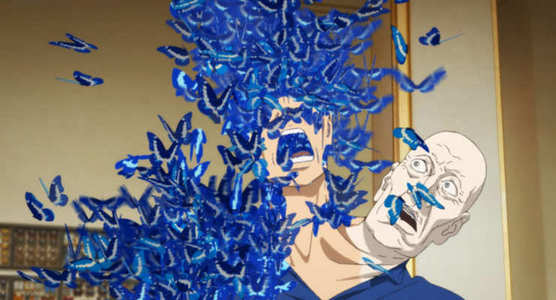
Video
A fantastic-looking 1.85:1 transfer. While it isn`t perfect -- there`s occasional noise and colour banding in the backgrounds -- it`s a sumptuous looking piece. A rich palette fed by a diet of primary colour, it`s pin-sharp with deep blacks and solid tones throughout. Madhouse are known for their vivid animation, but they`ve definitely outdone themselves this time. The sharp-lined, realistic approach with a dash of the obtuse works well throughout the movie, and the Blu-ray transfer brings out the best of the detail crammed into every frame. Despite almost a half of the scenes involving CGI work, the line between the two, aside from a few obvious moments, is near invisible and the character design is beautifully realised in a world where the squat, pudgy and exaggerated co-exist alongside the tall, lean and angular seamlessly, as if there wasn`t any other way.
* Viewed on a 32" 1366 x 768 panel at 720p
* The screenshots featured here are for illustrative purposes only. They were not taken from the Blu-ray source, and as such, the images are not representative of the quality of the disc.
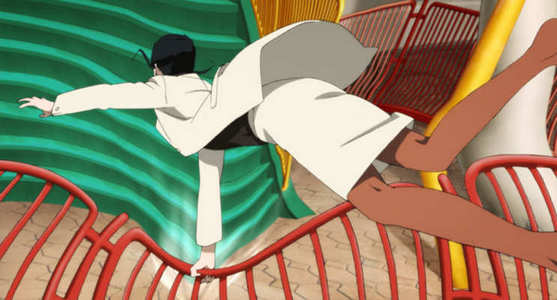
Audio
Uncompressed PCM 5.1 is the big boy on the disc, but only in native Japanese. I`m not in a position to review uncompressed soundtracks, so I won`t, but there`s a wealth of Dolby Digital 5.1 tracks on the disc which I am. Japanese and English are there of course, and the English dub isn`t half bad. Personally though, I chose to view it with its native track, but unlike certain dubs, I`m confident you won`t want to plug your ears with hand grenades five minutes after the feature starts. Quality-wise, the surround tracks are good. Strong and bold with well implemented direction, the score has a tendency to dance around the soundstage for effect, and there are enough whizzing spot effects to grease your ears a few times over.
Also present are full surround tracks in French, German, Italian, Spanish, Czech and Polish. The disc is also home to a ridiculous amount of subtitles, with almost every European language catered to.
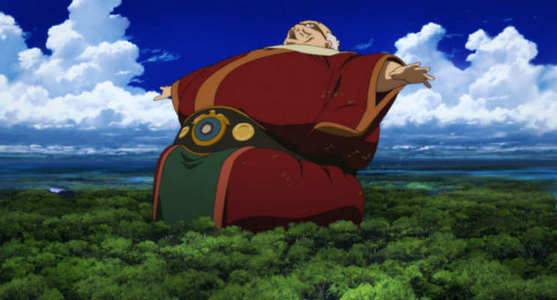
Features
Decent selection, which makes for a nice change around these parts:
First and foremost is the filmmaker`s commentary. Here, Satoshi Kon gets together with a couple of chaps from the crew -- specifically the music and art direction guys -- and deliver a breathless commentary which covers the technical, anecdotal and the completely off-topic. A well-performed yak-track with plenty of information and gaps a rarity, it`s a rewarding listen.
`The Making of Paprika` - a 30-minute feature, fairly standard after, what, 8 or 9 years of putting these things together for DVDs. There are some telling revelations though, particularly how the film rights to `Paprika` were hotly contested until everyone realised the novel was near-unfilmable by conventional means. Then there`s the point Yasutaka Tsutsui all but says `Paprika` the film and `Paprika` the novel bear only the core concepts in relation, and, my personal favourite, when Satoshi Kon reveals he came up with the images first, and slapped a story together to more-or-less frame them.
`A Conversation About The Dream` - possibly referring to `the dream` in general as regards the creative process, or possibly not, this feature is a 30-minute sitdown with Satoshi Kon, Yasutaka Tsutsui and the two main voice actors as they engage in a Q&A session of sorts, discussing their favourite scenes and various things of that ilk.
`The Art of Fantasy` and `The Dream CG World` are both short features examining the work of both the art direction and lead CGI coder respectively, and I don`t know about you, but I always find these sorts of features very interesting, and these are no exception.
`The Parade Scene`, `The Ruins Scene` and `Skin Slitting Scene` each allow you to examine storyboard comparisons, original drawings and character art from the aforementioned scenes.
There`s also a couple of trailers on the disc.
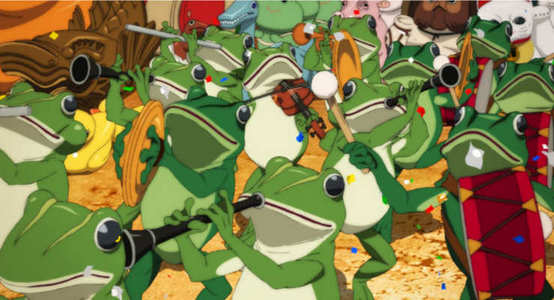
Conclusion
Critics of any sort are generally reluctant to knock something complex or that they don`t understand for fear that they just "didn`t get it", or at the very least, get accused of as much by those who "got it". Well, being the trailblazer that I am, I don`t think I got `Paprika`, and anyone who did can feel free to tell me what it is they got, and more importantly, how. It`s an aesthetically dazzling movie, its dynamism branding it as Satoshi Kon`s most triumphant visual tour-de-force, but it just doesn`t make a lick of sense. It`s a beautifully realised piece of optical poetry, but its narrative is near non-sequitur gibberish. It`s Satoshi Kon`s best film yet, and paradoxically, his worst. It looks great, but it smells kinda off. It`s hard to take a journey through the world of `Paprika` and, if you`re being honest with yourself, not come out the other end conflicted. In fact, there`s a scene in `Paprika` where, after watching a translucent child devour a man made of shadow and proceed to transform into a giant naked woman, two characters exchange a look. An eyes-wide-open, "what the f**k just happened" look. The look that I probably had on my face as the credits rolled.
Looking at it subjectively, `Paprika` is essentially a continuation of the Lynchian way Satoshi Kon explored the psychology of his characters in `Paranoia Agent`. But unlike his 2004 television show, his fourth feature film doesn`t have the plot chops to back it up. Most of the important, subtle narrative development is supposed to take place in the dreamscape, a whimsical realm with a malevolent undertone not dissimilar to the fantasy domain seen in Miyazaki`s grand opus `Spirited Away`, only Kon`s abstract wonderland rarely makes any sense, characters delivering nonsense dialogue, inexplicable events occurring and breaking the very rules previously established. And while cinematic accounts of dreams generally aren`t particularly cohesive -- full of non-linearity, fantasy interpolation and surrealistic segues -- it`s clear that Kon has had difficulty finding a balance between telling a story and presenting an incredible lightshow, any semblance of the former coming to a jarring halt about half way through as the latter comes into full, blinding effect. `Paprika` seems to give up on its characterisation and plot and simply launches into a series of dream-based scenarios where our heroes battle an unconvincing antagonist through a series of elaborate fantasy-vistas with very little purpose. Or at least very little purpose I cared to follow.
Of course, there`s much to be said for the wholesome understatement, a little audience participation and viewer interpretation, and many will argue that is the point of `Paprika`. But they`re wrong. Unless they`re talking about the analogy of technology displacing the natural world. If that`s what you`re after, go rent `Jurassic Park`. I eventually gave up on trying to follow what plot there is to `Paprika` and enjoyed it for the virtues it does have, namely the sublime trippiness and absolute splendor of its presentation. I`d imagine most people would do the same. It`s a beautiful film, one I`d certainly revisit and maybe even pick up on a few bits and pieces I "didn`t get" first time around, but it`s a scattershot feature that`s, disappointingly, less than the sum of its parts.
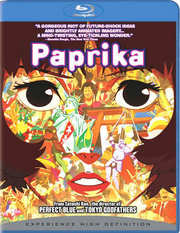











































Your Opinions and Comments
Be the first to post a comment!